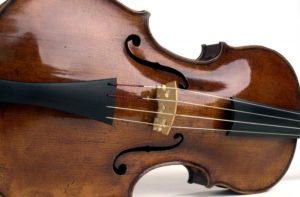
My viola was built in 1725 Vienna by Daniel Achatius Stadlmann, a very fine maker, not widely known outside our field, who also made particularly beautiful violas d’amore. It came into my life by a curious route.
Every other June, Boston Early Music Festival presents a fully staged baroque opera, features many concerts and symposia, and hosts an international exhibition of instrument makers of all sorts: dealers, string makers, publishing houses, you name it, all dedicated to historical performance. In June 1997 I was playing in the BEMF Orchestra, and at the end of one of our opera rehearsals, Robert Seletsky, a long-time colleague and a man with an encyclopedic knowledge of string instruments, was waiting, unannounced, to meet me. (When I say “encyclopedic knowledge,” I mean it! He is the author of most of the entries on historical violins and bows in the New Grove Dictionary of Music and Musicians.)
Robert Seletsky (fine New York accent): “Patrick, come with me. There’s a viola you need to meet. It’s perfect for you.”
Me: “Hi, Bob! How’s it going?”
RS: “Seriously, you need to see this thing now. It’s perfect for you. You’re gonna buy it.”
Me: “Bob, I just bought a viola about eight months ago. I don’t have any money. I’m not really looking for a viola right now.”
RS: “Come with me, you’re gonna buy it. Just, come on.”
What harm could come from taking a look? Off we went to the hotel room where the now-retired but once-legendary dealer and instrument repairer, William Monical, had set up shop.
I cannot say it was love at first sight. Some of you will know that over the centuries, string instruments have undergone subtle but important changes in what we call their “setup.” This includes physical properties of the instruments themselves, like the angle at which the neck is set into the body, the design and height of the bridge, the design and mass of the tailpiece, etc. and also extrinsic features, like the strings. The viola in question had been “modernized” sometime in the nineteenth century, and subsequently “re-baroqued” in the 1980s, but the work of “re-baroquing” it was not excellent, and the instrument was definitely not in its peak sounding condition. It was, however, intriguing on a number of fronts. The arching, or the curves carved into the top and back were some of the highest (most curvy, you could say) I had ever seen and of exquisite craftsmanship. And there was something about the sound, so sweet, so beautiful, so full of potential even if it wasn’t optimized.
A month later, as presaged by Robert Seletsky, I was the proud owner of a gorgeous, eighteenth-century viola. Six months later, in careful consultation with William Monical, we made the changes to the instrument that freed its best voice. It is not unreasonable to imagine that my viola was there, in the pit on the opening night of Gluck’s Orfeo or Mozart’s Don Giovanni, a fact that still tickles me!

